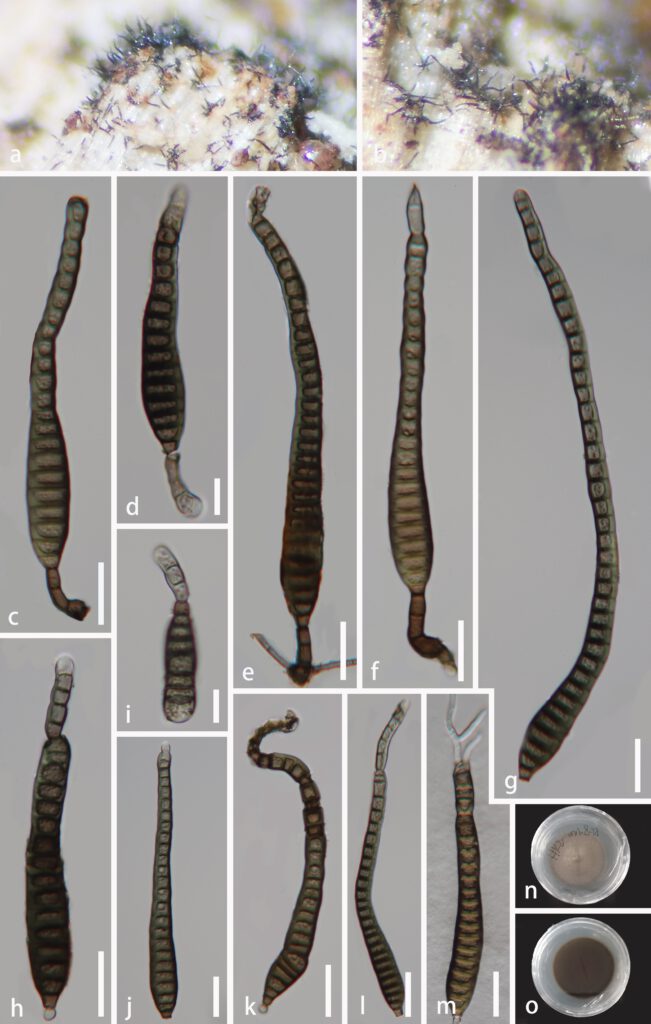Distoseptispora macrospora J Ma, K. D. Hyde & Y.Z. Lu, sp. nov. (Figure 3).
MycoBank number: MB; Index Fungorum number: IF; Facesoffungi number: FoF 11042;
Etymology: ‘macrospora’ referring to the ‘large’ conidia.
Holotype: HKAS 123754
Saprobic on decaying wood in terrestrial habitats. Sexual morph: Undetermined. Asexual morph: Colonies effuse, gregarious, brown or dark brown, hairy. Mycelium immersed and partly superficial, consisting of branched, septate, smooth, pale brown to brown. Conidiophores 14.2–44.1 μm × 3.8–7.4 μm (x̅ = 26.1 × 5.1 μm, n = 20), macronematous, mononematous, brown to dark brown, solitary, 2–4-septate, erect, straight or flexuous, unbranched, smooth, cylindrical, singly or in groups, truncate at the apex, slightly constricted at septa. Conidiogenous cells 4.2–8.6 μm × 3.9–5.4 μm (x̅ = 6.2 × 4.4 μm, n = 20), holoblastic, monoblastic, integrated, terminal, determinate, pale brown to brown, smooth, cylindrical. Conidia 50.1–242.3 μm × 10.9–20.4 μm (x̅ = 110.9 × 12.8 μm, n = 30) acrogenous, solitary, obclavate, rostrate, smooth-walled, straight or slightly curved, up to 38 – distoseptate, guttulate, olivaceous to dark brown, mostly slightly constricted at septa, tapering towards the rounded apex, truncate at the base.
Culture characteristics: Conidia germinating on PDA within 12 h and germ tubes produced from conidia. Colonies growing on PDA, reaching 40 mm diam. in 30 days at 25°C, circular, Mycelium flat, with dense, gray or brown. In reverse, dark brown.
Material examined: China, Hainan Province, Haikou city, Xiuying District, Ecological leisure trail, on decaying wood submerged in terrestrial habitat, 10 August 2021, Jian Ma, HK2 (HKAS 123754, holotype; GZAAS22-0079, isotype), ex-type living culture, GZCC22-0074.
GenBank accession numbers: (LSU), (ITS), (TEF1α) ON, (RPB2) ON.
Notes: The morphological characteristics of Distoseptispora macrospora match well with the generic concept of Distoseptispora[2]. Multi-gene analyses showed that D. macrospora is a phylogenetically-distinct species, most closely related to D. tectonigena, a species isolated from submerged wood in a terrestrial habitat[3]. D. macrospora forms a sister clade to D. chinense and D. tectonigena with weak support values (63% ML and 1 BYPP). However, D. macrospora has shorter conidiophores (14.2–44.1 × 3.8–7.4 μm vs. up to 110 × 5–11 μm) and shorter conidia (50.1–242.3 × 10.9–20.4 μm vs. 148–225 ×11–12 μm) than those of D. tectonigena[3,4]. Based on a pairwise nucleotide comparison of ITS, LSU and TEF1α, D. macrospora differs D. tectonigena in 14/ 561 bp (2.5%) for ITS, 3/ 854 bp (0.3%) for LSU, and 17/897 bp (1.9%) for RPB2, respectively and can be considered as distinct species according to the guidelines of Jeewon and Hyde[5].

Figure 3. Distoseptispora macrospora (HKAS 123754, holotype) a–b Colonies on natural substrate. c–f Conidiophores, conidiogenous cells and conidia. g–l Conidia. m Germinating conidium. m, o Culture on PDA from above and reverse. Scale bars: c, e–h, j–m = 20 μm, d, i = 10 μm
